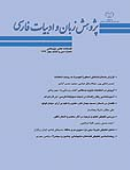آیرونی در شطحیات بایزید بسطامی
محورهای موضوعی : پژوهشهای ادبیات کلاسیک ایرانالهام روستاییراد 1 , مهين پناهي 2
1 -
2 -
کلید واژه: بایزید بسطامی شطح معرفت آیرونی سوررئالیسم,
چکیده مقاله :
آیرونی یکی از صناعات ادبی است که در چارچوب سخنی متناقض نمود و ظهور پیدا میکند. آیرونی برای بیان معنایی برجسته و دلالت بر مدلولی خاص به کار می رود و در نتیجه موجب برجستگی بخشی از کلام میشود. این صنعت به طور نهانی در قالب طنز، کنایه، مدح و ذم، در راه بیان مضمون در گسترۀ بلاغت سخن گام برمیدارد. این پژوهش درصدد است با روشی تحلیلی-توصیفی، جایگاه آیرونی را در شطحیات بجامانده از بایزید بسطامی تبیین کند. بایزید بسطامی، شطحیات بحث برانگیزی بنا بر عرفان و زهد آمیخته به عشق بیان کرده است. در این مقاله ابتدا مفهوم آیرونی، طنز و وجوه سوررئالیستی آن، مشخص شده، پس از آن شطحیات بنا بر چارچوب ساختاری خود بازنموده میشود. با تأمل در زبان شطحیات و قرینههای آن می توان دریافت که مقام معرفت با سوررئالیسم نیز در پیوند است. در پایان این جُستار، شطحیات متناقض نما و فراواقع، بر اساس صنعت آیرونی و در چارچوب مبانی تصوف و مقامات عرفانی مشخص و تبیین میشود.
Irony is a figure of speech which refers to the expression of the meaning by using a language which signifies the opposite. Irony is used to express a prominent meaning and to signify a special signified, and it results in highlighting a specific part of the discourse. This figure of speech expresses the meaning implicitly through satire, metonymy, praising and blaming and contributes to the rhetoricity of the text. This research using a descriptive analytic approach aims at explaining the status of irony in Bayazid Bastami's Shathiyat. Bayazid Bastami has controversial Shathiyat rooted in mysticism and ascetisim accompanied by love. In this article, the concepts of irony, satire, and surrealism aspects are defined at first. Then, Shathiyat will be represented in their structural framework. By reflecting on the language in Shathiyat and their symmetries we can understand that wisdom or knowledge is related to surrealism too. Finally, surreal and paradoxical Shathiyat will be illustrated and explained within the principles of Sufism and mysticism.


